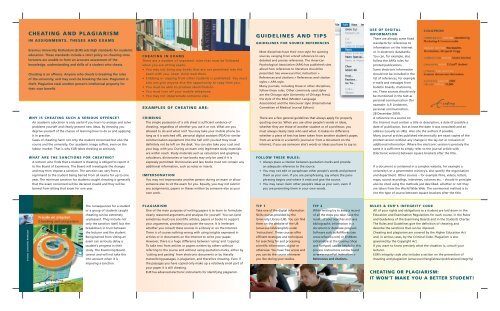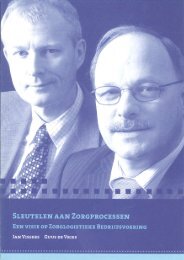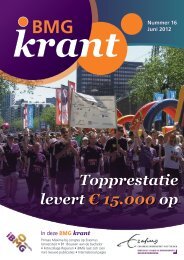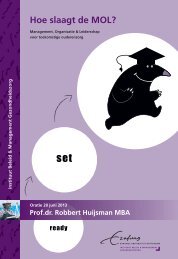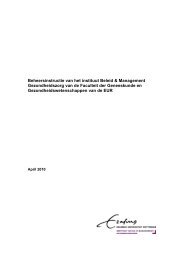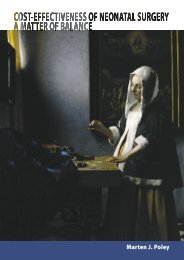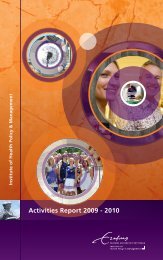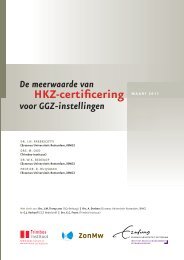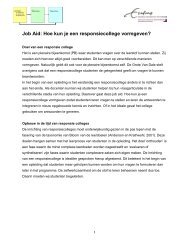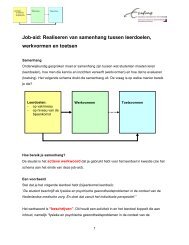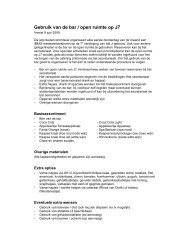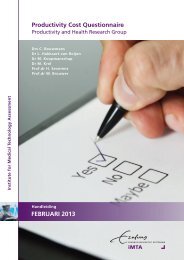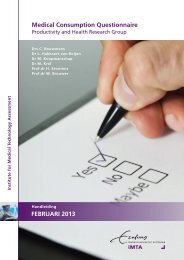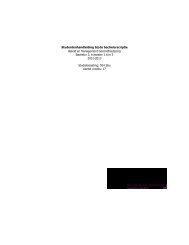CHEATING AND PLAGIARISM - Erasmus Universiteit Rotterdam
CHEATING AND PLAGIARISM - Erasmus Universiteit Rotterdam
CHEATING AND PLAGIARISM - Erasmus Universiteit Rotterdam
You also want an ePaper? Increase the reach of your titles
YUMPU automatically turns print PDFs into web optimized ePapers that Google loves.
<strong>CHEATING</strong> <strong>AND</strong> <strong>PLAGIARISM</strong><br />
IN ASSIGNMENTS, THESES <strong>AND</strong> EXAMS<br />
<strong>Erasmus</strong> University <strong>Rotterdam</strong> (EUR) sets high standards for academic<br />
education. These standards include a strict policy on cheating since<br />
lecturers are unable to form an accurate assessment of the<br />
knowledge, understanding and skills of a student who cheats.<br />
Cheating is an offence. Anyone who cheats is breaking the rules<br />
of the university, and may even be breaking the law. Plagiarism is<br />
theft. Plagiarists steal another person’s intellectual property for<br />
their own benefit.<br />
WHY IS <strong>CHEATING</strong> SUCH A SERIOUS OFFENCE?<br />
An academic education is only useful if you learn to analyse and solve<br />
problems yourself and clearly present new ideas. By cheating you<br />
deprive yourself of the chance of learning how to do so and applying<br />
it in practice.<br />
Cases of cheating harm not only the student concerned but also the<br />
course and the university. Our academic image suffers, even on the<br />
labour market. That is why EUR takes cheating so seriously.<br />
WHAT ARE THE SANCTIONS FOR <strong>CHEATING</strong>?<br />
A lecturer who finds that a student is cheating is obliged to report it<br />
to the Board of Examiners. The Board will investigate the charges<br />
and may then impose a sanction. The sanction can vary from a<br />
reprimand to the student being barred from all exams for up to one<br />
year. The minimum sanction for students caught cheating is generally<br />
that the exam concerned will be declared invalid and they will be<br />
barred from sitting that exam for one year.<br />
The consequences for a student<br />
or a group of students caught<br />
cheating can be extremely<br />
unpleasant. They include not<br />
only the sanction itself, but the<br />
breakdown in trust between<br />
the lecturer and the student.<br />
Being barred from sitting an<br />
exam can seriously delay a<br />
student’s progress in their<br />
study. The Examining Board<br />
cannot and will not take this<br />
into account when it is<br />
imposing a sanction.<br />
<strong>CHEATING</strong> IN EXAMS<br />
There are a number of important rules that must be followed<br />
when you are sitting exams.<br />
You may not bring any books that are not permitted into the<br />
exam with you, never mind read them.<br />
Cribbing or copying from other students is prohibited. You must<br />
also not give anyone else the opportunity to copy from you.<br />
You must be able to produce identification.<br />
You must turn off your mobile telephone.<br />
You may not impersonate someone else.<br />
EXAMPLES OF <strong>CHEATING</strong> ARE:<br />
CRIBBING<br />
The simple possession of a crib sheet is sufficient evidence of<br />
cheating, regardless of whether you use it or not. What are you<br />
allowed to do and what not? You may take your mobile phone (so<br />
long as it is switched off), personal digital assistant (PDA) or similar<br />
communication equipment into the hall with you but they must<br />
definitely not be left on the desk. You can also take your coat and<br />
your bag, with you. During an exam only legitimate study materials<br />
are within reach. Study materials such as calculators and graphing<br />
calculators, dictionaries or law books may only be used if it is<br />
expressly permitted. Dictionaries and law books must not contain any<br />
additional information, such as notes or inserts.<br />
IMPERSONATION<br />
You may not impersonate another person during an exam or allow<br />
someone else to sit the exam for you. Equally, you may not submit<br />
any assignments, papers or theses written by someone else as your<br />
own work.<br />
<strong>PLAGIARISM</strong><br />
One of the main purposes of writing papers is to learn to formulate<br />
clearly reasoned arguments and analyses for yourself. You can (and<br />
sometimes must) use scientific articles, papers or books to support<br />
your arguments, provided you quote the source. It is irrelevant<br />
whether you consult these sources in a library or on the Internet.<br />
There is of course nothing wrong with using insights expressed in<br />
articles or in documents on the Internet to write your paper.<br />
However, there is a huge difference between ‘using’ and ‘copying’.<br />
To take text from articles or papers written by others without<br />
referring to the source and without using quotation marks, either by<br />
‘cutting and pasting’ from electronic documents or by literally<br />
transcribing passages, is plagiarism, and therefore cheating. Even if<br />
the passages you have copied only make up a relatively small part of<br />
your paper it is still cheating.<br />
EUR has advanced electronic instruments for identifying plagiarism.<br />
GUIDELINES <strong>AND</strong> TIPS<br />
GUIDELINES FOR SOURCE REFERENCES<br />
Most disciplines have their own style for quoting<br />
sources, ranging from a brief reference to very<br />
detailed and precise references. The American<br />
Psychological Association (APA) has published rules<br />
about how references to literature should be<br />
presented. See www.eur.nl/ul_instruction ><br />
References and citations > References and citation<br />
styles > APA style.<br />
Many journals, including those in other disciplines,<br />
follow these rules. Other commonly used styles<br />
are the Chicago style (University of Chicago Press),<br />
the style of the MLA (Modern Language<br />
Association) and the Vancouver style (International<br />
Committee of Medical Journal Editors).<br />
There are a few general guidelines that always apply for properly<br />
quoting sources. When you use other people’s words or ideas,<br />
whether they are those of another student or of a professor, you<br />
must always clearly state who said what. It makes no difference<br />
whether a piece of text has been taken from another student’s paper,<br />
from an article in a scientific journal or from a document on the<br />
Internet, if you use someone else’s words or ideas you have to say so.<br />
FOLLOW THESE RULES:<br />
Always place a citation between quotation marks and provide<br />
an adequate reference to the source.<br />
You may not edit or paraphrase other people’s words and present<br />
them as your own. If you are paraphrasing, say where the paraphrasing<br />
begins and where it ends and give the source.<br />
You may never claim other people’s ideas as your own, even if<br />
you are presenting them in your own words.<br />
12<br />
TIP 1<br />
Take one of the digital Information<br />
Skills courses provided by the<br />
University Library (UB). You can find<br />
them on the website of the UB<br />
(www.eur.nl/ub/english) under<br />
‘instructions’. These courses offer<br />
efficient strategies and techniques<br />
for searching for and processing<br />
scientific information, digital or<br />
otherwise. You have free access and<br />
you can do the course when ever<br />
you like during your studies.<br />
TIP 2<br />
While writing try to keep a record<br />
of all the steps you take. Save the<br />
results of your searches and save<br />
bibliographic information in a<br />
document or database program.<br />
Software such as RefWorks (see<br />
www.refworks.com) or EndNote<br />
(obtainable at the <strong>Erasmus</strong> Shop<br />
and Surfspot) can be helpful in this<br />
process. Instructions can be found<br />
at www.eur.nl/ul_instruction ><br />
References and citations..<br />
USE OF DIGITAL<br />
INFORMATION<br />
There are already some fixed<br />
standards for references to<br />
information on the Internet<br />
or in electronic databanks.<br />
You can, for example, also<br />
follow the APA’s rules for<br />
printed publications.<br />
Some electronic information<br />
should not be included in the<br />
list of references, for example<br />
e-mails and messages from<br />
bulletin boards, chatrooms,<br />
etc. These sources should only<br />
be mentioned in the text as<br />
personal communication (for<br />
example: A.P. Lindstrom,<br />
personal communication,<br />
28 December 2001).<br />
A reference to a source on<br />
the Internet must contain a title or description, a date (if possible a<br />
date of publication, but at least the date it was consulted) and an<br />
address (usually an URL). Also cite the authors if possible.<br />
Many journal articles published electronically are exact copies of the<br />
printed version without any change in the lay out or inclusion of<br />
additional information. Where the electronic version is precisely the<br />
same it is sufficient to simply refer to the journal article with<br />
[Electronic version] between square brackets after the title.<br />
If a document is contained in a complex website, for example a<br />
university’s or a government ministry’s, also specify the organisation<br />
and department. Other sources – for example films, videos, letters,<br />
maps, sound recordings, interviews, columns etc. – should in principle<br />
also be cited using the methods just described, whether or not they<br />
are taken from the World Wide Web. The commonest method is to<br />
cite the type of source between square brackets after the title.<br />
RULES & EUR’S INTEGRITY CODE<br />
All of your rights and obligations as a student are laid down in the<br />
Education and Examination Regulations for each course, in the Rules<br />
and Guidelines of the Examining Boards and in the Students Charter.<br />
The Rules and Guidelines give the definition of cheating and<br />
describe the sanctions that can be imposed.<br />
Cheating and plagiarism are covered by the Higher Education Act<br />
and, in serious cases, by the Criminal Code. Plagiarism is also<br />
governed by the Copyright Act.<br />
If you want to know precisely what the situation is, consult your<br />
lecturer.<br />
EUR’s integrity code also includes a section on the prevention of<br />
cheating and plagiarism (www.eur.nl/english/eur/publications/integrity)<br />
<strong>CHEATING</strong> OR <strong>PLAGIARISM</strong>:<br />
IT WON’T MAKE YOU A BETTER STUDENT!
FRAUDE EN PLAGIAAT<br />
BIJ WERKSTUKKEN, SCRIPTIES EN TENTAMENS<br />
De <strong>Erasmus</strong> <strong>Universiteit</strong> <strong>Rotterdam</strong> (EUR) stelt hoge eisen aan<br />
academische vorming. Daarbij hoort een streng fraudebeleid.<br />
Immers, in geval van fraude kan de docent geen goed oordeel<br />
vormen omtrent kennis, inzicht en vaardigheden van de student.<br />
Fraude is een overtreding. Wie fraude pleegt, overtreedt de regels<br />
van de universiteit en in sommige gevallen de wet. Plagiaat is<br />
diefstal. Wie plagieert eigent zich het intellectuele eigendom<br />
van iemand anders toe om er zelf beter van te worden.<br />
VOORBEELDEN VAN FRAUDE ZIJN:<br />
SPIEKEN<br />
Een spiekblaadje is al genoeg voor het vaststellen van fraude, ongeacht<br />
of er gebruik van is gemaakt. Wat mag verder wel en niet? Je<br />
uitgeschakelde mobiel, pda (personal digital assistent) of vergelijkbare<br />
communicatieapparatuur mogen mee de zaal in, maar beslist niet<br />
op tafel liggen. Ook je jas en je tas mag je meenemen. Tijdens een<br />
tentamen ligt alleen geoorloofd studiemateriaal onder handbereik.<br />
Studiemateriaal zoals een (grafische) rekenmachine, een woordenboek<br />
of wetboek mag slechts worden gebruikt als dit uitdrukkelijk is<br />
toegestaan. Woordenboeken en wetboeken mogen geen andere<br />
informatie zoals aantekeningen of inlegvellen bevatten.<br />
PERSOONSVERWISSELING<br />
Tijdens een tentamen mag je je niet uitgeven voor een ander;<br />
evenmin mag iemand anders jouw tentamen maken. En net zo<br />
min mag je opdrachten, werkstukken en scripties die door een<br />
ander gemaakt zijn, onder je eigen naam inleveren.<br />
PLAGIAAT<br />
Een belangrijk doel van het schrijven van werkstukken is het zelf<br />
leren een goed onderbouwde redenering of analyse te formuleren.<br />
Bij het onderbouwen van die redenering kun je (of moet je zelfs)<br />
gebruik maken van wetenschappelijke artikelen, papers of boeken,<br />
mits je aan bronvermelding doet. Het maakt niet uit of je deze bronnen<br />
raadpleegt in een bibliotheek of op internet. Er is uiteraard<br />
niets op tegen om bij het schrijven van werkstukken gebruik te<br />
maken van inzichten zoals die zijn verwoord in artikelen of in documenten<br />
op internet.<br />
Er is echter wel een belangrijk verschil tussen ‘gebruik maken van’ en<br />
‘kopiëren’. Neem je zonder bronvermelding én zonder gebruik te<br />
maken van aanhalingstekens teksten over uit artikelen of uit door<br />
anderen geschreven werkstukken, hetzij door te ‘knippen en plakken’<br />
uit elektronische documenten, hetzij door passages letterlijk<br />
over te typen, dan is er sprake van plagiaat: van fraude dus. Zelfs als<br />
de gekopieerde passages maar een relatief klein deel uitmaken van<br />
je werkstuk, is er sprake van frauduleus handelen. De EUR beschikt<br />
over geavanceerde middelen om plagiaat elektronisch op te sporen.<br />
WAAROM IS FRAUDE EEN SERIEUS VERGRIJP?<br />
Een wetenschappelijke opleiding heeft pas nut als je leert zelfstandig<br />
problemen te analyseren, te verwoorden en nieuwe ideeën op een<br />
overzichtelijke manier te ontwikkelen. Door fraude te plegen ontneem<br />
je jezelf de kans dit goed te leren en toe te passen.<br />
Fraudegevallen die aan het licht komen schaden niet alleen de pleger,<br />
maar ook de opleiding en de universiteit. Ons academisch imago<br />
loopt in zo’n geval een deuk op, ook op de arbeidsmarkt. Daarom tilt<br />
de EUR zwaar aan fraude.<br />
WELKE SANCTIES STAAN ER OP FRAUDE?<br />
Een docent die fraude op het spoor komt, is verplicht dit te melden<br />
bij de examencommissie. De commissie onderzoekt de beschuldiging<br />
en kan vervolgens een sanctie opleggen; die kan variëren van een<br />
berisping tot uitsluiting van alle tentamens voor maximaal één jaar.<br />
Doorgaans is de minimale sanctie ongeldigverklaring van het<br />
betreffende tentamen én uitsluiting van dat tentamen voor de duur<br />
van een jaar.<br />
De consequenties van geconstateerde fraude voor een individuele<br />
student of groep studenten kunnen bijzonder onaangenaam zijn.<br />
Het gaat hierbij niet alleen om de sanctie zelf, maar ook om de vertrouwensbreuk<br />
die optreedt tussen student en docent.<br />
Een frauderende student kan door de uitsluiting van het tentamen<br />
ernstige studievertraging oplopen. De examencommissie kan en zal<br />
hiermee geen rekening houden bij het opleggen van de sanctie.<br />
FRAUDE BIJ TENTAMENS<br />
Bij het maken van tentamens<br />
gelden een paar belangrijke<br />
afspraken.<br />
Niet toegestane boeken mag<br />
je niet bij je hebben, laat<br />
staan inzien.<br />
Spieken (afkijken) is verboden.<br />
Ook het bieden van gelegenheid<br />
tot spieken is niet<br />
toegestaan.<br />
Je moet je kunnen legitimeren.<br />
Je mobiele telefoon moet<br />
uitgeschakeld zijn.<br />
Je mag je niet voor een ander<br />
uitgeven.<br />
VUISTREGELS EN TIPS<br />
VUISTREGELS BIJ BRONVERMELDING<br />
Iedere wetenschap kent een eigen stijl van bronvermelding,<br />
variërend van kort tot zeer uitgebreid<br />
en nauwkeurig. De American Psychological<br />
Association (APA) heeft regels gepubliceerd over<br />
de wijze waarop literatuurverwijzingen dienen te<br />
worden gemaakt (www.eur.nl/ub_instructie > verwijzen<br />
en citeren > citeerstijlen > APA-stijl).<br />
Veel tijdschriften – ook in andere disciplines –<br />
volgen deze voorschriften. Andere veel gebruikte<br />
stijlen zijn: Chicago style (University of Chicago<br />
Press), MLA (Modern Language Association), en<br />
de Vancouver style (International Committee of<br />
Medical Journal Editors).<br />
Voor een goede bronvermelding geldt een aantal algemene richtlijnen<br />
waaraan altijd moet worden voldaan. Wanneer je woorden of ideeën<br />
gebruikt van anderen, of het nu van een medestudent of van een professor<br />
is, je moet altijd helder aangeven wie wat heeft gezegd. Het maakt ook<br />
niet uit of een tekst is ontleend aan een werkstuk van een medestudent,<br />
aan een wetenschappelijk artikel of aan een document van het internet.<br />
Als je teksten en ideeën van anderen gebruikt, moet je dit vermelden.<br />
HOUD JE AAN DEZE REGELS:<br />
Zet een citaat altijd tussen aanhalingstekens en vermeld de bron<br />
op correcte wijze.<br />
Je mag teksten van anderen niet redigeren of parafraseren en het<br />
presenteren als je eigen werk. Als je parafraseert, geef dan aan waar<br />
je begint met parafraseren en waar je eindigt en vermeld de bron.<br />
Ideeën van anderen mag je nooit, ook niet in je eigen woorden,<br />
toeschrijven als afkomstig van jezelf.<br />
12<br />
TIP 1<br />
Volg een van de digitale cursussen<br />
Informatievaardigheden van<br />
de <strong>Universiteit</strong>sbibliotheek (UB).<br />
Je vindt ze op de website van de<br />
UB (www.eur.nl/ub) bij<br />
‘Instructies’. Deze cursussen<br />
bieden efficiënte strategieën en<br />
technieken bij het zoeken naar<br />
en verwerken van (digitale)<br />
wetenschappelijke informatie.<br />
Ze zijn vrij toegankelijk en je<br />
kunt ze op elk moment tijdens<br />
je studie volgen.<br />
TIP 2<br />
Probeer tijdens het schrijfproces<br />
alle gemaakte stappen te registreren,<br />
zoekresultaten vast te leggen<br />
en bibliografische informatie<br />
op te slaan in een document of<br />
databaseprogramma. Software<br />
zoals RefWorks (zie<br />
www.refworks.com) of Endnote<br />
(verkrijgbaar in de <strong>Erasmus</strong> Shop<br />
en bij Surfspot) kan je hierbij<br />
behulpzaam zijn. Instructies zijn<br />
te vinden op UB-webpagina<br />
www.eur.nl/ub_instructie > verwijzen<br />
en citeren.<br />
GEBRUIK VAN DIGITALE INFORMATIE<br />
Er zijn inmiddels vaste regels om te verwijzen naar informatie op<br />
internet of in elektronische databanken. Ook hierbij is aan te sluiten<br />
bij bijvoorbeeld de APA-regels voor gedrukte publicaties.<br />
Neem sommige elektronische informatie niet op in de literatuurlijst,<br />
bijvoorbeeld e-mailberichten en berichten van bulletin boards en<br />
chatrooms en dergelijke. Vermeld die alleen in de tekst als persoonlijke<br />
communicatie (bijvoorbeeld: A.P. Lindstrom, persoonlijke communicatie,<br />
28 december 2001).<br />
Een referentie naar een internetbron moet een titel of omschrijving<br />
bevatten, een datum (als het kan een publicatiedatum, in ieder geval<br />
de datum van raadpleging) en een adres (meestal een URL). Vermeld<br />
ook auteurs als dat mogelijk is.<br />
Veel elektronische tijdschriftartikelen zijn exacte kopieën van de<br />
gedrukte versie zonder dat er sprake is van wijzigingen in lay-out of<br />
van additionele informatie. Bij zo'n exacte kopie volstaat een gewone<br />
verwijzing naar het tijdschriftartikel met achter de titel tussen<br />
vierkante haken toegevoegd [Electronic version].<br />
Als een document opgenomen is op een complexe website, zoals van<br />
een universiteit of ministerie, vermeld dan ook de organisatie en<br />
afdeling. Ook andere bronnen - denk aan films, video's, brieven,<br />
kaarten, geluidsopnamen, interviews, columns enz., al dan niet van<br />
het World Wide Web gehaald - worden in principe op de bovengenoemde<br />
manieren geciteerd. De meest gangbare manier is de soort<br />
bron tussen vierkante haken achter de titel te vermelden.<br />
SPELREGELS & INTEGRITEITSCODE EUR<br />
Alles over je rechten en verplichtingen als student is vastgelegd in de<br />
Onderwijs Examen Regelingen van elke opleiding, in de Regels en<br />
Richtlijnen van de Examencommissies en in het Studentenstatuut.<br />
In de Regels en Richtlijnen staat wat onder fraude verstaan wordt en<br />
welke maatregelen getroffen kunnen worden.<br />
Fraude en plagiaat vallen onder de Wet Hoger Onderwijs en in<br />
ernstige gevallen onder het wetboek van Strafrecht. Plagiaat wordt<br />
daarnaast nog beheerst door de Auteurswet.<br />
Wil je precies weten hoe de vork in de steel zit, raadpleeg dan je<br />
docent en de website www.eur.nl/plagiaat.<br />
Het tegengaan van fraude en plagiaat maakt deel uit van de<br />
integriteitscode van de EUR, zie ook:<br />
www.eur.nl/eur/corporate_publicaties/integriteitscode<br />
FRAUDE OF PLAGIAAT:<br />
JE WORDT ER NIET BETER VAN!<br />
Z-CARD ® PocketMedia ® (Dit zijn handelsmerken van Z Industries Limited).<br />
Dit product bestaat uit een dubbel gevouwen blad. Deze producten en de<br />
hierbij gebruikte machines en processen worden beschermd door in<br />
Nederland en over de gehele wereld aangevraagde en verleende octrooien,<br />
copyright, handelsmerk en andere rechten op intellectueel eigendom, zoals<br />
bijvoorbeeld Europees Octrooi Nummers EP 602090 © 2009, Z Industries<br />
Ltd. Vervaardigd onder licentie door Z-CARD ® LTD, London Tel +44 (0)207<br />
924 5147. Sales office: Z-CARD ® Ltd. PO box 10016, 1001 EA Amsterdam<br />
Benelux@zcard.com<br />
www.zcard.com No. 27434/16


